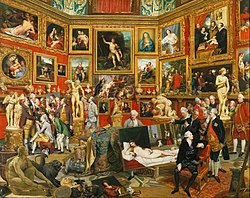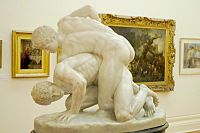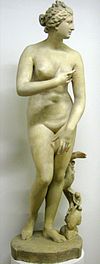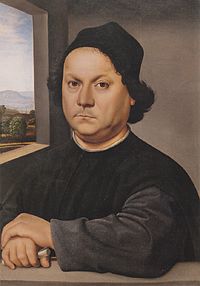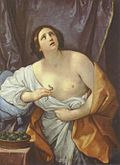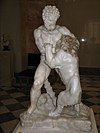Archivo:The Tribuna of the Uffizi (1772-78); Zoffany, Johann.jpg

Este archivo es de Wikimedia Commons y puede usarse en otros proyectos. La descripción en su página de descripción del archivo se muestra debajo.
Resumen
| Johann Zoffany: La Tribuna de los Uffizi
|
||||||||||||||||||||||||||||
|---|---|---|---|---|---|---|---|---|---|---|---|---|---|---|---|---|---|---|---|---|---|---|---|---|---|---|---|---|
| Artista |
artist QS:P170,Q702272 |
|||||||||||||||||||||||||||
| Título |
The Tribuna of the Uffizi |
|||||||||||||||||||||||||||
| Object type |
pintura |
|||||||||||||||||||||||||||
| Género |
art gallery painting |
|||||||||||||||||||||||||||
| Personas retratadas |
|
|||||||||||||||||||||||||||
| Fecha | hacia 1772-1778 | |||||||||||||||||||||||||||
| Técnica |
óleo sobre tela medium QS:P186,Q296955;P186,Q12321255,P518,Q861259 |
|||||||||||||||||||||||||||
| Dimensiones |
altura: 124 cm; ancho: 155 cm dimensions QS:P2048,124U174728 dimensions QS:P2049,155U174728 |
|||||||||||||||||||||||||||
| Colección |
institution QS:P195,Q42646 |
|||||||||||||||||||||||||||
| Ubicación actual | ||||||||||||||||||||||||||||
| Número de inventario |
RCIN 406983 (Royal Collection) |
|||||||||||||||||||||||||||
| Historial de la pieza |
|
|||||||||||||||||||||||||||
| Referencias | ||||||||||||||||||||||||||||
| Fuente/fotógrafo | Windsor | |||||||||||||||||||||||||||
| Otras versiones |
 |
|||||||||||||||||||||||||||
Licencia
|
Esta es una reproducción fotográfica fiel de una obra de arte bidimensional de dominio público. La obra de arte misma se halla en el dominio público por el motivo siguiente:
La postura oficial de la Fundación Wikimedia considera que «las reproducciones fieles de obras de arte bidimensionales de dominio público forman parte del dominio público».
Esta reproducción fotográfica, por ende, también se considera de dominio público dentro de los Estados Unidos. Es posible que otras jurisdicciones restrinjan la reutilización de este contenido; consúltese Reutilización de fotografías PD-Art (en inglés) para más detalles. | |||||
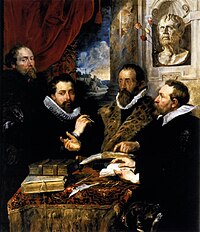
Rubens, Self-portrait with 3 friends
(Four Philosophers), now at the Pitti Palace

Raphael, Saint John the Baptist
(Category:John the Baptist by Raphael (Florence))
Baby Hercules strangling two serpents
Workshop of Guercino, Sibyl
Amor and Psyche
Leyendas
Elementos representados en este archivo
representa a
Historial del archivo
Haz clic sobre una fecha/hora para ver el archivo a esa fecha.
| Fecha y hora | Miniatura | Dimensiones | Usuario | Comentario | |
|---|---|---|---|---|---|
| actual | 23:13 25 feb 2007 |  | 1050 × 850 (200 KB) | M.chohan | The Tribuna of the Uffizi (1772-78); Zoffany, Johann.jpg {{PD-Art}} |
Usos del archivo
La siguiente página enlaza a este archivo:
Metadatos
| Comentario de archivo JPEG | ZOFFANY, Johann
(b. 1733, Frankfurt, d. 1810, Strand-on-the-Green) The Tribuna of the Uffizi 1772-78 Oil on canvas, 123,5 x 154,9 cm Royal Collection, Windsor The painting has become one of the most celebrated images of eighteenth-century taste. Zoffany shows a group of connoisseurs and members of the nobility admiring works of art in the Tribuna, the principal room of the Uffizi in Florence, which was the most famous gallery in the world during the eighteenth century. The Tribuna had been built by Francesco de' Medici in 1585-9 to a design by Bernardo Buontalenti as a showcase for the most precious items in the Medici collection. Although Zoffany has depicted the architectural features of the Tribuna with a fair degree of accuracy, he has rearranged the works of art and in some cases altered their scale. In fact, he has also incorporated a number of paintings from that part of the Medici collection housed in the Palazzo Pitti, as well as including several additional pieces of sculpture. The painter thus successfully gives the gallery a more crowded and undoubtedly richer appearance than it had during the eighteenth century, and by this means has facilitated his rendering of the complicated sightlines of the room and the perspectival inlaid marble decoration of the floor. The setting is therefore somewhat idealised, but it remains a perfectly accurate representation of the significance of the Tribuna for eighteenth-century connoisseurship, with its emphasis on the antique, the High Renaissance, the Bolognese school and Rubens. Zoffany painted the picture in Florence expressly for Queen Charlotte, beginning in 1772. Much of the composition was completed the following year, but the artist continued working on it intermittently until late in 1777, making changes some of which are now only visible by X-ray. Notable among these changes is the inclusion of a self portrait on the left of the composition, where the artist has shown himself peering round the unframed canvas of the Virgin and Child by Raphael. For this purpose, it is almost as if the painter has abandoned his easel, partly visible in the lower right corner of the picture, and walked across or around the back of the room to partake in the discussion. The figures in the picture, all of whom are identifiable, fall into three groups: those on the left between the sculptures of Cupid and Psyche and Satyr with the Cymbals; those in the foreground, right of centre, gathered around the Venus d'Urbino by Titian; and those on the right around the Venus de' Medici. These portraits were meticulously painted by Zoffany and won widespread admiration, although apparently not from George III and Queen Charlotte, who claimed that such recognisable figures were inappropriate to the scene. In essence, however, Zoffany has amalgamated the traditional subject of a gallery view, much exploited by Flemish painters in the seventeenth century, with the conversation piece evolved by British painters during the eighteenth century, although recently other more cryptic levels of meaning have been sought in the picture. Royal patronage enabled the artist to have the Venus d'Urbino by Titian taken down from the wall for copying after the Grand Duke of Tuscany (Ferdinando I) had specifically decreed that the picture had been copied too much and should not be moved again for such a purpose. Correspondingly, there are one or two references in the picture to the Royal Collection: the Virgin and Child by Raphael, held by the artist, was a work that was offered to George III by Earl Cowper (this is the Niccolini-Cowper Madonna, now in the National Gallery of Art, Washington) and the Samian Sibyl by Guercino, seen at the lower edge of the composition, is a pendant to the Libyan Sibyl by the same artist bought by George III in the 1760s. The Tribuna of the Uffizi is a technical tour de force. The attention to detail and texture involves not just the portraits, but also the copies after the works of art nearly all of which are identifiable. Controlled brushwork and careful application are the hallmarks of Zoffany's style, and they are seen at their best in this famous picture without any of the loss of verve that such a long and elaborate undertaking might have forced upon the artist. <P> <TABLE ALIGN=LEFT CELLPADDING=5 BORDER=1 WIDTH=320 BGCOLOR="#99CCCC"> <TR VALIGN=MIDDLE><TD><IMG SRC="/support/gif/listen.gif" BORDER=0 VALIGN=MIDDLE> Suggested listening (streaming mp3, 19 minutes):<BR><A HREF="#" onClick="w=window.open ('/music1/19_cent/mussorgsky_exhibition_excerpts.html', 'newWin', 'scrollbars=yes,status=no,dependent=yes,screenX=0,screenY=0,width=350,height=350');w.opener=this;w.focus();return true"><B>Modest Mussorgsky: Picture from an Exhibition, arr. by Maurice Ravel (excerpts)</B></A> </TD></TR></TABLE>
Author: ZOFFANY, Johann Title: The Tribuna of the Uffizi Time-line: 1751-1800 School: German Form: painting Type: interior |
|---|

